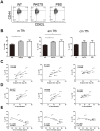An HIV-1 envelope immunogen with W427S mutation in CD4 binding site induced more T follicular helper memory cells and reduced non-specific antibody responses
- PMID: 25546013
- PMCID: PMC4278894
- DOI: 10.1371/journal.pone.0115047
An HIV-1 envelope immunogen with W427S mutation in CD4 binding site induced more T follicular helper memory cells and reduced non-specific antibody responses
Abstract
The CD4 binding site (CD4BS) of the HIV-1 envelope glycoprotein (Env) contains epitopes for broadly neutralizing antibody (nAb) and is the target for the vaccine development. However, the CD4BS core including residues 425-430 overlaps the B cell superantigen site and may be related to B cell exhaustion in HIV-1 infection. Furthermore, production of nAb and high-affinity plasma cells needs germinal center reaction and the help of T follicular helper (Tfh) cells. We believe that strengthening the ability of Env CD4BS in inducing Tfh response and decreasing the effects of the superantigen are the strategies for eliciting nAb and development of HIV-1 vaccine. We constructed a gp120 mutant W427S of an HIV-1 primary R5 strain and examined its ability in the elicitation of Ab and the production of Tfh by immunization of BALB/c mice. We found that the trimeric wild-type gp120 can induce more non-specific antibody-secreting plasma cells, higher serum IgG secretion, and more Tfh cells by splenocyte. The modified W427S gp120 elicits higher levels of specific binding antibodies as well as nAbs though it produces less Tfh cells. Furthermore, higher Tfh cell frequency does not correlate to the specific binding Abs or nAbs indicating that the wild-type gp120 induced some non-specific Tfh that did not contribute to the production of specific Abs. This gp120 mutant led to more memory Tfh production, especially, the effector memory Tfh cells. Taken together, W427S gp120 could induce higher level of specific binding and neutralizing Ab production that may be associated with the reduction of non-specific Tfh but strengthening of the memory Tfh.
Conflict of interest statement
Figures





Similar articles
-
HIV-1 gp120-CD4-Induced Antibody Complex Elicits CD4 Binding Site-Specific Antibody Response in Mice.J Immunol. 2020 Mar 15;204(6):1543-1561. doi: 10.4049/jimmunol.1901051. Epub 2020 Feb 17. J Immunol. 2020. PMID: 32066595 Free PMC article.
-
Increased, Durable B-Cell and ADCC Responses Associated with T-Helper Cell Responses to HIV-1 Envelope in Macaques Vaccinated with gp140 Occluded at the CD4 Receptor Binding Site.J Virol. 2017 Sep 12;91(19):e00811-17. doi: 10.1128/JVI.00811-17. Print 2017 Oct 1. J Virol. 2017. PMID: 28701402 Free PMC article.
-
The role of follicular helper T cells and the germinal center in HIV-1 gp120 DNA prime and gp120 protein boost vaccination.Hum Vaccin Immunother. 2014;10(7):1985-92. doi: 10.4161/hv.28659. Hum Vaccin Immunother. 2014. PMID: 25424808 Free PMC article.
-
The role of follicular helper CD4 T cells in the development of HIV-1 specific broadly neutralizing antibody responses.Retrovirology. 2018 Aug 6;15(1):54. doi: 10.1186/s12977-018-0437-y. Retrovirology. 2018. PMID: 30081906 Free PMC article. Review.
-
Tfh cells and HIV bnAbs, an immunodominance model of the HIV neutralizing antibody generation problem.Immunol Rev. 2017 Jan;275(1):49-61. doi: 10.1111/imr.12512. Immunol Rev. 2017. PMID: 28133798 Review.
Cited by
-
Investigation of the cytotoxicity of bioinspired coumarin analogues towards human breast cancer cells.Mol Divers. 2021 Feb;25(1):307-321. doi: 10.1007/s11030-020-10082-6. Epub 2020 Apr 23. Mol Divers. 2021. PMID: 32328962 Free PMC article.
-
Env Exceptionalism: Why Are HIV-1 Env Glycoproteins Atypical Immunogens?Cell Host Microbe. 2020 Apr 8;27(4):507-518. doi: 10.1016/j.chom.2020.03.018. Cell Host Microbe. 2020. PMID: 32272076 Free PMC article. Review.
References
-
- Flynn NM, Forthal DN, Harro CD, Judson FN, Mayer KH, et al. (2005) Placebo-controlled phase 3 trial of a recombinant glycoprotein 120 vaccine to prevent HIV-1 infection. J Infect Dis 191:654–665. - PubMed
-
- Pitisuttithum P, Gilbert P, Gurwith M, Heyward W, Martin M, et al. (2006) Randomized, double-blind, placebo-controlled efficacy trial of a bivalent recombinant glycoprotein 120 HIV-1 vaccine among injection drug users in Bangkok, Thailand. J Infect Dis 194:1661–1671. - PubMed
Publication types
MeSH terms
Substances
LinkOut - more resources
Full Text Sources
Other Literature Sources
Research Materials

